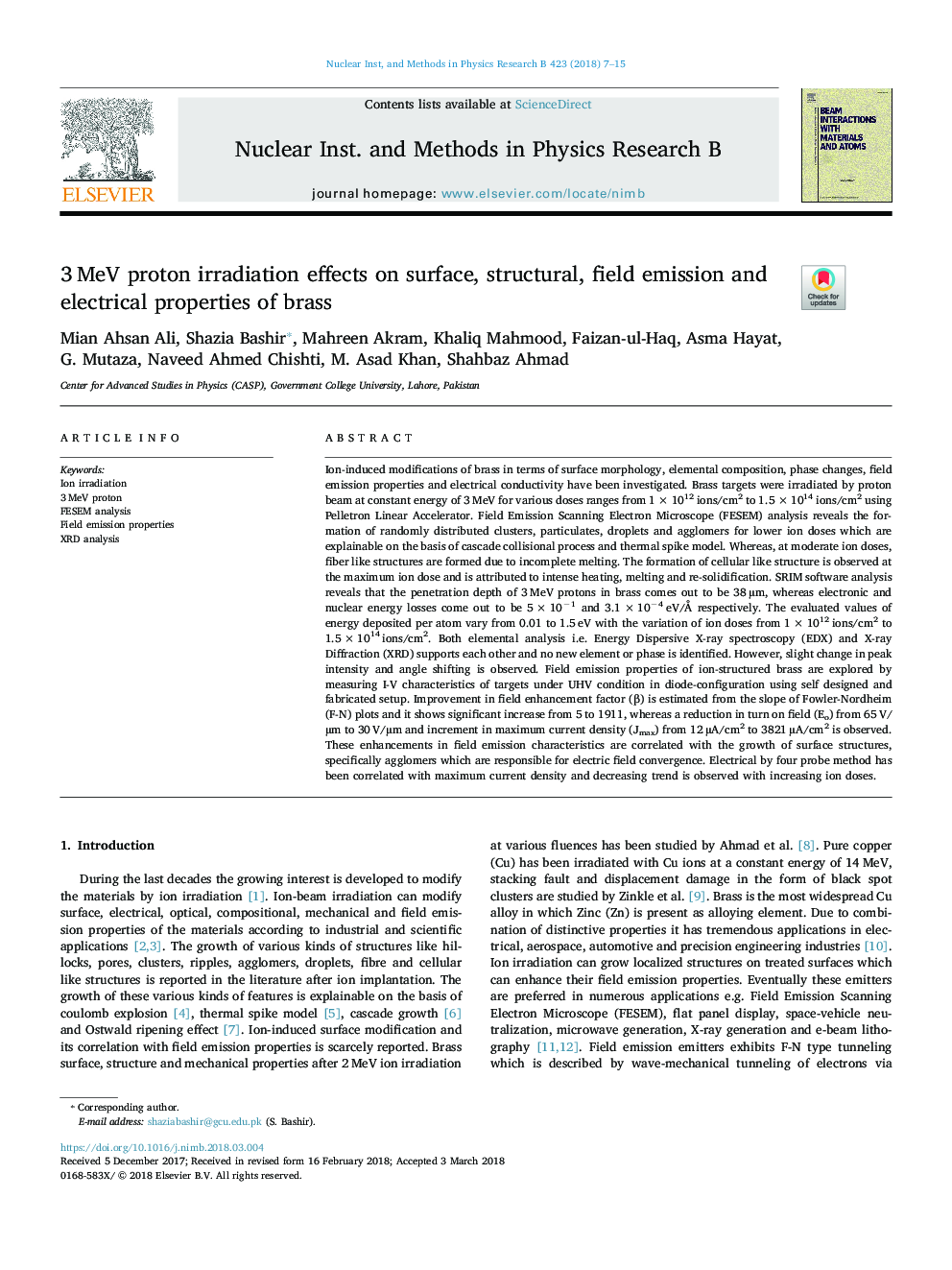| کد مقاله | کد نشریه | سال انتشار | مقاله انگلیسی | نسخه تمام متن |
|---|---|---|---|---|
| 8039184 | 1518600 | 2018 | 9 صفحه PDF | دانلود رایگان |
عنوان انگلیسی مقاله ISI
3â¯MeV proton irradiation effects on surface, structural, field emission and electrical properties of brass
دانلود مقاله + سفارش ترجمه
دانلود مقاله ISI انگلیسی
رایگان برای ایرانیان
کلمات کلیدی
موضوعات مرتبط
مهندسی و علوم پایه
مهندسی مواد
سطوح، پوششها و فیلمها
پیش نمایش صفحه اول مقاله

چکیده انگلیسی
Ion-induced modifications of brass in terms of surface morphology, elemental composition, phase changes, field emission properties and electrical conductivity have been investigated. Brass targets were irradiated by proton beam at constant energy of 3â¯MeV for various doses ranges from 1â¯Ãâ¯1012â¯ions/cm2 to 1.5â¯Ãâ¯1014â¯ions/cm2 using Pelletron Linear Accelerator. Field Emission Scanning Electron Microscope (FESEM) analysis reveals the formation of randomly distributed clusters, particulates, droplets and agglomers for lower ion doses which are explainable on the basis of cascade collisional process and thermal spike model. Whereas, at moderate ion doses, fiber like structures are formed due to incomplete melting. The formation of cellular like structure is observed at the maximum ion dose and is attributed to intense heating, melting and re-solidification. SRIM software analysis reveals that the penetration depth of 3â¯MeV protons in brass comes out to be 38â¯Âµm, whereas electronic and nuclear energy losses come out to be 5â¯Ãâ¯10â1 and 3.1â¯Ãâ¯10â4â¯eV/Ã
respectively. The evaluated values of energy deposited per atom vary from 0.01 to 1.5â¯eV with the variation of ion doses from 1â¯Ãâ¯1012â¯ions/cm2 to 1.5â¯Ãâ¯1014â¯ions/cm2. Both elemental analysis i.e. Energy Dispersive X-ray spectroscopy (EDX) and X-ray Diffraction (XRD) supports each other and no new element or phase is identified. However, slight change in peak intensity and angle shifting is observed. Field emission properties of ion-structured brass are explored by measuring I-V characteristics of targets under UHV condition in diode-configuration using self designed and fabricated setup. Improvement in field enhancement factor (β) is estimated from the slope of Fowler-Nordheim (F-N) plots and it shows significant increase from 5 to 1911, whereas a reduction in turn on field (Eo) from 65â¯V/µm to 30â¯V/µm and increment in maximum current density (Jmax) from 12â¯ÂµA/cm2 to 3821â¯ÂµA/cm2 is observed. These enhancements in field emission characteristics are correlated with the growth of surface structures, specifically agglomers which are responsible for electric field convergence. Electrical by four probe method has been correlated with maximum current density and decreasing trend is observed with increasing ion doses.
ناشر
Database: Elsevier - ScienceDirect (ساینس دایرکت)
Journal: Nuclear Instruments and Methods in Physics Research Section B: Beam Interactions with Materials and Atoms - Volume 423, 15 May 2018, Pages 7-15
Journal: Nuclear Instruments and Methods in Physics Research Section B: Beam Interactions with Materials and Atoms - Volume 423, 15 May 2018, Pages 7-15
نویسندگان
Mian Ahsan Ali, Shazia Bashir, Mahreen Akram, Khaliq Mahmood, Faizan-ul-Haq Faizan-ul-Haq, Asma Hayat, G. Mutaza, Naveed Ahmed Chishti, M. Asad Khan, Shahbaz Ahmad,